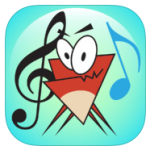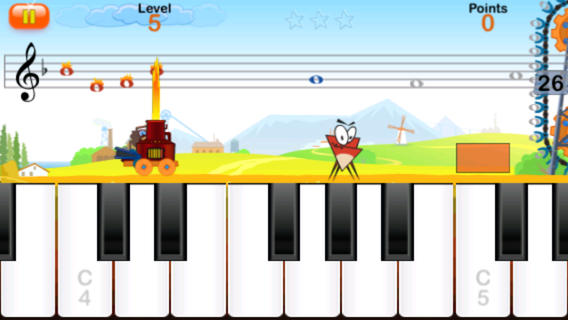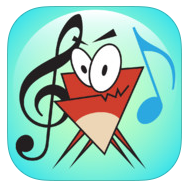 About a year ago, I wrote a review for the NoteWorks app for iPad (read it here). The developers of NoteWorks have notified me that they have recently released an iPhone version of NoteWorks. This is great news for any of your students/parents who own iPhones but do not own an iPad!
About a year ago, I wrote a review for the NoteWorks app for iPad (read it here). The developers of NoteWorks have notified me that they have recently released an iPhone version of NoteWorks. This is great news for any of your students/parents who own iPhones but do not own an iPad!
The iPhone version works very much like the iPad version. The only possible downside I perceived is that because of the smaller screen, the size of the staff and notes is smaller. The game still works very well, though. With young beginners, I would opt to use NoteWorks on the iPad, though, for the sake of the larger staff size.

The new iPhone version introduces a new way for students to select the range of notes on the staff they would like to practice.

Here are links to all of the versions available:
GIVEAWAY: NoteWorks has generously offered promo codes for FIVE lucky winners to be able to download this app for free. To enter the giveaway, leave a comment below before midnight EST on Monday, November 11, 2013 with a fun tip for teaching note names to your students. (Note: the giveaway is for the iPhone version of this app. However, the developer let me know that it is possible to use the iPhone version of NoteWorks on your iPad.)



Cool looking app! I use a stack of cards and pennies as game pieces. My students and I compete to see who gets to middle C first by going through the stack of note cards. pretty simple.
I have been waiting for this to come out for iPhone! Thanks for the review.
Well, this looks awesome. My students LOVE when we use the iPad. Thanks for hosting a giveaway!
One of my favourite “low-tech” ways to reinforce note names is the fly-swatter game. I lay out cards with the letter names A-G & then use a stack of flashcards with staff notes. First one to swat the right letter wins that card. Can be done in group or solo.
I agree with MaryBeth… My students love when we do an iPad activity. It’s an easy way to break up a lesson (especially when the young ones get antsy!) while still working on their music skills!
We play guide note slap jack. I use a deck of grand staff flashcards and turn them up one at a time. Each student has a flyswatter (never used for flies) and if a Music Tree guide note comes up they slap it. If they can name it and play it they keep it and all the cards underneath. If they slap a note that is not a guide note they lose all their cards. It is by far my students’ favorite game!
I love using apps to enhance piano lessons. Love to try this !!
In a class situation, I used to use music note flashcards to play “Around the World.” Students are seated in a circle, one student stands behind a seated student and the first one to name the note gets to stand behind the next seated student in the circle, thus going “around the world” if they are the quickest to name the note. Can’t wait to try this app for iphone as I don’t have an ipad!
I like sticking worksheets into cheap photo/document frames and having students complete them with dry-erase markers.
Exciting, I have heard many great things about this app! I like to use your game “The Amazing Keyboard Race” because my students always love it!
My students enjoy working on the iPad, iPhone and iPod touch.
We use old fashioned drills and flash card methods!
I love this…it is so cute and colorful, the kids will have a great time playing this while siblings are in the lesson. It’s easy and doesn’t take a lot of reading to start. Thanks for this opportunity…..
There are several online videos that have catchy songs. We use them with our younger beginner students to remember the note names. Here is the favorite from the last couple of weeks: http://www.youtube.com/watch?v=N46FFgxE6ns
Hey 🙂 I give every student a sheet with rhymes to memorise. FACE and Every Good Boy Deserves Football for treble clef and All Cows Eat Grass and Grizzly Bears Don’t Fear Anything for the Bass Clef. And oldie but a goodie 🙂
My students like this one: http://youtu.be/Ri1-YHJgE9g
It’s a little creepy with the dancing guy, but memorable nevertheless.
oops, this is not the one with the creepy guy, that is this one: http://youtu.be/3Uvv4PU0lSs
I’ve been wanting this app! One game I play with my students to help them learn note names is by having a “Spelling Bee” where they have to spell out words with note flashcards.
We use Boomwhackers to learn note names. Find the note on the staff….and on the piano….and then you get to Boomwhack the correct letter name! Great for younger students. Gets them moving on and off the bench A LOT!
Would love to try this app – thanks for the giveaway! We use Flashclass all the time but this looks like another fun one to add to our collection of games.
What works best for my students to connect note-reading to playing on the pian is to show them a flash card, and they have to play the correct note on the piano and say the name. 🙂
(I can’t remember where exactly I learned this story originally.) They learn about the two black keys as the garage and three black keys as the house. Doggy D lives inside, with an elephant E to the right and cat C to the left. Inside the house lives ___ G and ___ A (they get to choose the names) — and some get really excited they get to make something fun up! Then we learn there’s a front F and back B door of the house that the people go in and out of/from.
After they know it, I drill their note names by getting them to run from the wall to the piano playing notes I call out. It’s usually most fun when it’s timed!
Hello 🙂
I teach students from various range of ages so my approaches will depend to their age.
My youngest students are around 3 or 4 yo, and I start introducing them with do-re-mi first before going to the letter names, since I think it would be helpful for their aural development.
I will tell the story that the music house (the grand staff) has so many children, and there is a kid who always stays outside the house of G clef who always wears a hat (the leger line on mid-C), which is “do” , next he has a sister, “re” whose head is near the house, “mi” who likes to peek in first line, “fa” who stays in a first room (space) and “so” who stays in second line”.. And so on.
After they recognize that it goes higher and lower respectively and could logically think what note is which by singing “do re mi”, I’d start telling them that each not has a nickname which is “C” “D” “E”, etc..
It takes time sometimes, but I’m glad that so far my students really memorize each note because they “understand” the basic concept.
I’ve been following your blog since the beginning of this teaching year. Thanks for all of your excellent recommendations and thoughts on playing/practicing/artistry.
For my students, I’ve been having them use Music Learning Community. I also like doing musical spelling words – and we can do that on staff paper as well as on the keyboard using pennies.
I play “Name That Note” which is simply flash cards and a stopwatch. The student gets 30 seconds to name as many notes as possible. The reward: 1 M&M or Skittle for each correct note. I’m amazed at what kids will do for one M&M!! It’s been a favorite for years. Also do “Plunk a Note” on the piano with the same idea.
Note works is one of my student’s favorite ! I’m sure my parents with iPhones will like this new version. I have my students at school play a beanbag game to learn/ review note names.
we just practice, practice by quizzing and also the note race game where we put painters tape on the ground for a staff and have them race to see who can stand where the note would be. I have also used the tenuto app on the iPad.
The 1 minute club for learning notes gives students a real sense of accomplishment. Off the bench activities get them excited.
I have the free version and my students love it! Would love to have the full version. For note names we memorize the different acronyms everyone uses but try to find a way to personalize it so that they remember it. 🙂
This is my favorite app for older elementary students.
During the summer, we do the 1 minute challenge– to name and play all the notes on the staff in a minute. I was hesitant when I first read about it (I believe it was on Susan Paradis’s blog), but my students love it. Throughout the year I do many small activities to reinforce the concepts, but the one minute club really seems to give a boost to those students to really master their note naming.
We “hide” their flashcards throughout the room, the student finds one, plays it on the piano and tells me its name. We do 5 at a time, then another 5, then combine those to work on 10 at a time, and so on.
I use flashcards, games, dry erase board and some drills. I’m planning to buy an iPad, and this app sounds like it would be great!